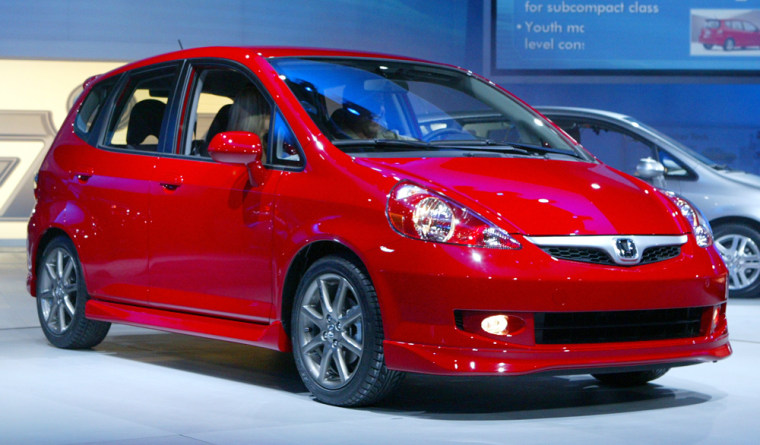When it comes to vehicle purchases, Americans like to think big. Large cars with plenty of brawn have always been their style. But with predictions that gasoline prices will soar again this summer, a new breed of tiny cars could soon grab a sizeable chunk of the U.S. automobile market.
The cars in question include the 2007 Honda Fit, which made its U.S. debut at the Detroit Auto Show in earlier this year and goes on sale April 20 with a suggested retail price of between $13,000 and $14,000. The Fit will go fender to fender with other new entrants in the small-car market, including the recently-released Toyota Yaris and the Nissan Versa. Other compact-car models include the Hyundai Accent, Kia Rio and Chevrolet Aveo.
Demand for these cars is likely to spike this spring as concerns about costly pump prices grow. Gasoline prices rushed back into the national headlines recently amid predictions of price spikes and shortages during the all-important summer driving season, when gasoline demand usually peaks. The reason: The phase-out of a fuel additive found to contaminate groundwater and a shortage of the ethanol used to replace it. With supplies already stretched to the limit, spot shortages could bring significant price spikes.
“Gasoline price spikes will generally help sales of the Fit and compact cars in general,” said Jesse Toprak, executive director of industry analysis for Edmunds.com, an Internet-based resource for consumer automotive information.
Forecasts of summer gas price spikes are well-timed for small car markers, Toprak said, noting that consumers have limited automobile choices when gas prices rise — smaller cars and vehicles powered by fuel-saving hybrid gas-electric motors.
“From a practical aspect, when you do the math the hybrid alternative is not always best financial choice because they cost more, and so a smaller car with a fuel economy of 30 miles per gallon is an attractive alternative, especially in urban areas,” Toprak said.
While there is almost always a correlation between the price of gas and the types of cars consumers buy, the consumer’s mindset has shifted, said Toprak. Most car buyers think gas will never go back to $1 again and is likely to stay above $2, and might be even higher at other times of the year. “We are very likely to see $3 in May or June, and prices are not likely to abate until after the summer and may actually stay at that level,” he added.
Jack Nerad, market analyst at Kelley Blue Book, a resource for new and used vehicle information, wonders whether Americans will remain enamored with smaller cars.
“The key thing here is will all this catch on?” Nerad said. “There’s a lot of talk and buzz, but these cars seem to be dependent on the price of gasoline and over the course of time Americans don’t seem to stay with subcompacts very long, but that’s certainly not the way things go in Europe, Asia and Canada.”
Nerad also notes that smaller cars don’t necessarily bring big profits for automotive manufacturers, paraphrasing auto pioneer Henry Ford who once said small cars only bring small profits. “That has been a truism in the industry for the last 40 years,” Nerad said. “There is more price pressure on these cars because their buyers are economically-challenged.”
More important to automakers is the marketing role these cars fill. With most buyers of subcompact cars first-time car consumers, the hope is that they can bring some brand loyalty — that is, a buyer purchases a small Yaris and then graduates to a Camry, and then one to a Lexus and stays in the brand family Nerad added.
Smaller cars, like the subcompact, 5-door Honda Fit hatchback, may be short on stature but they are long on standard safety features and add-ons. The Fit includes front and side curtain airbags, an anti-lock braking system (ABS), an optional five-speed automatic transmission and steering wheel-mounted paddle shifters on the Fit Sport model.
Customization is also important, says Toprak. Toyota’s Yaris, which comes with as a two-door “liftback,” or a four-door sedan, includes an auxiliary audio jack to attach to an iPod, or another MP3 player. These are not the oft-shunned small cars of old, Toprak said.
“The difference now is they are designed well and have lot of amenities that you would normally expect to see in a larger, mid-sized car,” he said. “And now we are seeing more opportunities for people to customize these cars — that’s how the success of the Mini and Scion brand came about. The more you can personalize a car in this segment, the better it will do. The manufacturers of these vehicles have designs on the youth market, where customization has been shown to be important to consumers.”
Small-car buyers shouldn’t expect to pay smaller prices, Toprak notes. Discounts are not often found in hot car segments or for new releases, he said, and discounts are not likely until the fall of 2006.
“If you can wait until the end of the summer, then wait; it always pays to wait out the first few months of new car introduction,” he said, adding that some hot-selling cars, like the Chrysler 300 and the Ford Mustang, have held their pricing point beyond three months.
“Typically, if there isn’t a big rush and there’s enough inventory, you’ll see a discount,” Toprak said. “But as these cars are reasonably priced, don’t expect a big one — maybe just a few hundred dollars off the sticker price. These cars are not especially profitable for manufacturers, and from a dealership perspective they make money on aftermarket sales of wheels, audio upgrades and other add-ons.”
